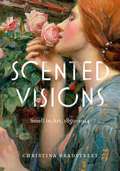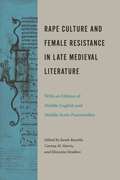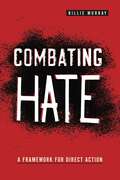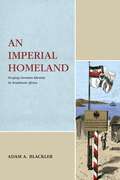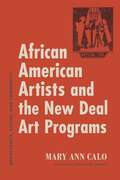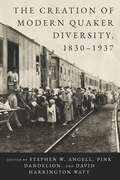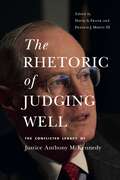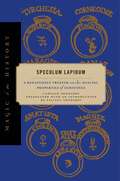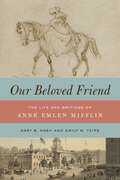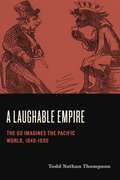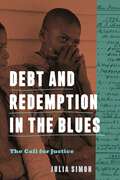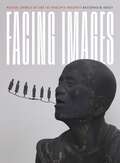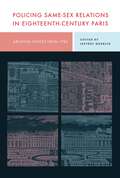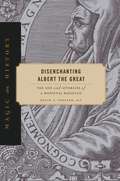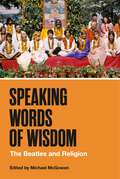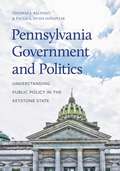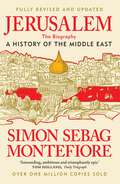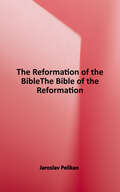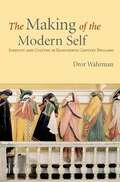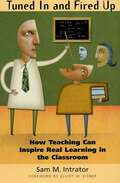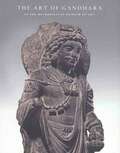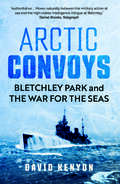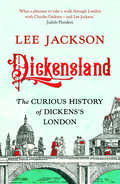- Table View
- List View
Scented Visions: Smell in Art, 1850-1914 (Perspectives on Sensory History)
by Christina BradstreetSmell loomed large in cultural discourse in the late nineteenth century, thanks to the midcentury fear of miasma, the drive for sanitation reform, and the rise in artificial perfumery. Meanwhile, the science of olfaction remained largely mysterious, prompting an impulse to “see smell” and inspiring some artists to picture scent in order to better know and control it. This book recovers the substantive role of the olfactory in Pre-Raphaelite art and Aestheticism.Christina Bradstreet examines the iconography and symbolism of scent in nineteenth-century art and visual culture. Fragrant imagery in the work of John Everett Millais, Dante Gabriel Rossetti, Simeon Solomon, George Frederic Watts, Edward Burne-Jones, and others set the trend for the preoccupation with scent that informed swaths of British, European, and American art and design. Bradstreet’s rich analyses of paintings, perfume posters, and other works of visual culture demonstrate how artworks mirrored the “period nose” and intersected with the most clamorous debates of the day, including evolution, civilization, race, urban morality, mental health, faith, and the “woman question.”Beautifully illustrated and grounded in current practices in sensory history, Scented Visions presents both fresh readings of major works of art and a deeper understanding of the cultural history of nineteenth-century scent.
Rape Culture and Female Resistance in Late Medieval Literature: With an Edition of Middle English and Middle Scots Pastourelles
by Sarah Baechle, Carissa M. Harris and Elizaveta StrakhovCentering on the difficult and important subject of medieval rape culture, this book brings Middle English and Scots texts into conversation with contemporary discourses on sexual assault and the #MeToo movement. The book explores the topic in the late medieval lyric genre known as the pastourelle and in related literary works, including chivalric romance, devotional lyric, saints’ lives, and the works of major authors such as Margery Kempe and William Dunbar. By engaging issues that are important to feminist activism today—the gray areas of sexual consent, the enduring myth of false rape allegations, and the emancipatory potential of writing about survival—this volume demonstrates how the radical terms of the pastourelle might reshape our own thinking about consent, agency, and survivors’ speech and help uncover cultural scripts for talking about sexual violence today.In addition to embodying the possibilities of medievalist feminist criticism after #MeToo, Rape Culture and Female Resistance in Late Medieval Literature includes an edition of sixteen Middle English and Middle Scots pastourelles. The poems are presented in a critical framework specifically tailored to the undergraduate classroom.Along with the editors, the contributors to this volume include Lucy M. Allen-Goss, Suzanne M. Edwards, Mary C. Flannery, Katharine W. Jager, Scott David Miller, Elizabeth Robertson, Courtney E. Rydel, and Amy N. Vines.
Combating Hate: A Framework for Direct Action (Rhetoric and Democratic Deliberation)
by Billie MurrayThe United States has a hate problem. In recent years, hate speech has led not only to deep division in our politics but also to violence, murder, and even insurrection. And yet established constitutional jurisprudence holds that all speech is protected as “content neutral” and that the proper democratic response to hateful expression is not regulation but “more speech.” So how can ordinary citizens stand up to hate groups when the state will not?In Combating Hate, Billie Murray proposes an answer to this question. As a participant in anti-racist and anti-fascist protests, including demonstrations against the Ku Klux Klan, neo-Nazis, and the Westboro Baptist Church, Murray witnessed firsthand the limitations of the “more speech” approach as well as the combative tactics of anti-fascist activists. She argues that this latter group, commonly known as antifa, embodies a radically different strategy for combating hate, one that explodes the myth of content neutrality and reveals hate speech to be a tactic of fascist organizing with very real, highly anti-democratic consequences. Drawing on communication theory and this on-the-ground experience, Murray presents a new strategy, which she calls “allied tactics,” rooted in the commitment to affirm, support, and even protect those who are the victims of hate speech.Engaging and sophisticated, Combating Hate contends that there are concrete ways to fight hate speech from the front lines. Murray’s urgent argument that we reconsider how to confront and fight this blight on American life is essential reading for the current era.
The Fruit of Her Hands: Jewish and Christian Women’s Work in Medieval Catalan Cities (Iberian Encounter and Exchange, 475–1755)
by Sarah Ifft DeckerIn the thriving urban economies of late thirteenth-century Catalonia, Jewish and Christian women labored to support their families and their communities. The Fruit of Her Hands examines how gender, socioeconomic status, and religious identity shaped how these women lived and worked.Sarah Ifft Decker draws on thousands of notarial contracts as well as legal codes, urban ordinances, and Hebrew responsa literature to explore the lived experiences of Jewish and Christian women in the cities of Barcelona, Girona, and Vic between 1250 and 1350. Relying on an expanded definition of women’s work that includes the management of household resources as well as wage labor and artisanal production, this study highlights the crucial contributions women made both to their families and to urban economies. Christian women, Ifft Decker finds, were deeply embedded in urban economic life in ways that challenge traditional dichotomies between women in northern and Mediterranean Europe. And while Jewish women typically played a less active role than their Christian counterparts, Ifft Decker shows how, in moments of communal change and crisis, they could and did assume prominent roles in urban economies.Through its attention to the distinct experiences of Jewish and Christian women, The Fruit of Her Hands advances our understanding of Jewish acculturation in the Iberian Peninsula and the shared experiences of women of different faiths. It will be welcomed by specialists in gender studies and religious studies as well as students and scholars of medieval Iberia.
An Imperial Homeland: Forging German Identity in Southwest Africa (Max Kade Research Institute)
by Adam A. BlacklerAt the turn of the twentieth century, depictions of the colonized world were prevalent throughout the German metropole. Tobacco advertisements catered to the erotic gaze of imperial enthusiasts with images of Ovaherero girls, and youth magazines allowed children to escape into “exotic domains” where their imaginations could wander freely. While racist beliefs framed such narratives, the abundance of colonial imaginaries nevertheless compelled German citizens and settlers to contemplate the world beyond Europe as a part of their daily lives.An Imperial Homeland reorients our understanding of the relationship between imperial Germany and its empire in Southwest Africa (present-day Namibia). Colonialism had an especially significant effect on shared interpretations of the Heimat (home/homeland) ideal, a historically elusive perception that conveyed among Germans a sense of place through national peculiarities and local landmarks. Focusing on colonial encounters that took place between 1842 and 1915, Adam A. Blackler reveals how Africans confronted foreign rule and altered German national identity. As Blackler shows, once the façade of imperial fantasy gave way to colonial reality, German metropolitans and white settlers increasingly sought to fortify their presence in Africa using juridical and physical acts of violence, culminating in the first genocide of the twentieth century.Grounded in extensive archival research, An Imperial Homeland enriches our understanding of German identity, allowing us to see how a distant colony with diverse ecologies, peoples, and social dynamics grew into an extension of German memory and tradition. It will be of interest to German Studies scholars, particularly those interested in colonial Africa.
African American Artists and the New Deal Art Programs: Opportunity, Access, and Community
by Mary Ann CaloThis book examines the involvement of African American artists in the New Deal art programs of the 1930s. Emphasizing broader issues informed by the uniqueness of Black experience rather than individual artists’ works, Mary Ann Calo makes the case that the revolutionary vision of these federal art projects is best understood in the context of access to opportunity, mediated by the reality of racial segregation.Focusing primarily on the Federal Art Project (FAP) of the Works Progress Administration (WPA), Calo documents African American artists’ participation in community art centers in Harlem, in St. Louis, and throughout the South. She examines the internal workings of the Harlem Artists’ Guild, the Guild’s activities during the 1930s, and its alliances with other groups, such as the Artists’ Union and the National Negro Congress. Calo also explores African American artists’ representation in the exhibitions sponsored by WPA administrators and the critical reception of their work. In doing so, she elucidates the evolving meanings of the terms race, culture, and community in the interwar era. The book concludes with an essay by Jacqueline Francis on Black artists in the early 1940s, after the end of the FAP program.Presenting essential new archival information and important insights into the experiences of Black New Deal artists, this study expands the factual record and positions the cumulative evidence within the landscape of critical race studies. It will be welcomed by art historians and American studies scholars specializing in early twentieth-century race relations.
The Creation of Modern Quaker Diversity, 1830–1937 (The New History of Quakerism)
by Stephen W. Angell, Pink Dandelion, and David Harrington WattThe period from 1830 to 1937 was transformative for modern Quakerism. Practitioners made significant contributions to world culture, from their heavy involvement in the abolitionist and women’s rights movements and creation of thriving communities of Friends in the Global South to the large-scale post–World War I humanitarian relief efforts of the American Friends Service Committee and Friends Service Council in Britain.The Creation of Modern Quaker Diversity, 1830–1937 explores these developments and the impact they had on the Quaker religion and on the broader world. Chapters examine the changes taking place within the denomination at the time, including separations, particularly in the United States, that resulted in the establishment of distinct branches, and a series of all-Quaker conferences in the early twentieth century that set the agenda for Quakerism. Written by the leading experts in the field, this engaging narrative and penetrating analysis is the authoritative account of this period of Quaker history. It will appeal to scholars and lay Quaker readers alike and is an essential volume for meeting libraries. In addition to the editors, the contributors include Joanna Clare Dales, Richard Kent Evans, Douglas Gwyn, Thomas D. Hamm, Robynne Rogers Healey, Julie L. Holcomb, Sylvester A. Johnson, Stephanie Midori Komashin, Emma Jones Lapsansky, Isaac Barnes May, Nicola Sleapwood, Carole Dale Spencer, and Randall L. Taylor.
The Rhetoric of Judging Well: The Conflicted Legacy of Justice Anthony M. Kennedy (Rhetoric and Democratic Deliberation)
by David A. Frank And Francis J. Mootz IIIKnown as the “swing justice,” Justice Anthony M. Kennedy provided the key vote determining which way the Supreme Court would decide on some of the most controversial cases in US history. Though criticized for his unpredictable rulings, Kennedy also gained a reputation for his opinion writing and, more so, for his legal rhetoric.This book examines Justice Kennedy’s legacy through the lenses of rhetoric, linguistics, and constitutional law. Essays analyze Kennedy’s opinion writing in landmark cases such as Romer v. Evans, Obergefell v. Hodges, and Planned Parenthood v. Casey. Using the Justice’s rhetoric as an entry point into his legal philosophy, this volume reveals Kennedy as a justice with contradictions and blind spots—especially on race, women’s rights, and immigration—but also as a man of empathy deeply committed to American citizenship.A sophisticated assessment of Justice Kennedy’s jurisprudence, this book provides new insight into Kennedy’s legacy on the Court and into the role that rhetoric plays in judging and in communicating judgment.In addition to the editors, the contributors to this volume are Ashutosh Bhagwat, Elizabeth C. Britt, Martin Camper, Michael Gagarin, James A. Gardner, Eugene Garver, Leslie Gielow Jacobs, Sean Patrick O’Rourke, Susan E. Provenzano, Clarke Rountree, Leticia M. Saucedo, Darien Shanske, Kathryn Stanchi, and Rebecca E. Zietlow.
Speculum Lapidum: A Renaissance Treatise on the Healing Properties of Gemstones (Magic in History)
by Camillo LeonardiIn early modern Europe precious and semiprecious stones were valued not only for their beauty and rarity but also for their medical and magical properties. Lorenzo de’ Medici, Philip II of Spain, and Popes Leo X and Clement VII were all treated with expensive potions incorporating ground gems such as rubies, diamonds, and emeralds. Medical and magical/astrological lapidaries, texts describing the stones’ occult and medical qualities as well as their abilities to ward off demons and incantations, were essential resources for their use. First published in Venice in 1502, Camillo Leonardi’s Speculum Lapidum is an encyclopedic summary of all classical and medieval sources of lithotherapy.In describing the natural, manifest, and occult properties of precious and semiprecious stones as well as their graven images and applications, the Speculum Lapidum provides tremendous insight into the role that medical astrology and astral magic played in the life of an Italian court in the early modern period. Liliana Leopardi’s English translation, complete with critical apparatuses, gives unprecedented access to this key text within the magical lapidary genre. A vital addition to the existing canon of lapidaria in translation, Leopardi’s work will be of special importance for students and scholars of the history of magic, medicine, religion, and Renaissance humanism, and it will fascinate anyone interested in the occult properties of precious and semiprecious stones.
Our Beloved Friend: The Life and Writings of Anne Emlen Mifflin
by Gary B. Nash Emily M. TeipeBorn into one of the wealthiest families in Philadelphia and raised and educated in that vital center of eighteenth-century American Quakerism, Anne Emlen Mifflin was a progressive force in early America. This detailed and engaging biography, which features Mifflin’s collected writings and selected correspondence, revives her legacy.Anne grew up directly across the street from the Pennsylvania statehouse, where the Continental Congress was leading the War of Independence. A Quaker minister whose busy pen, agile mind, and untiring moral energy produced an extensive corpus of writings, Anne was an ardent abolitionist and social reformer decades before the establishment of women’s anti-slavery societies. And at a time when most Americans never ventured beyond their own village, hamlet, or farm, Anne journeyed thousands of miles. She traveled to settlements of Friends on the frontier and met with Native Americans in the rough country of northwestern Pennsylvania, New York, and Canada. Our Beloved Friend provides a unique window onto the lives of Quakers during the pre-Revolutionary era, the establishment of the New Republic, and the War of 1812.
A Laughable Empire: The US Imagines the Pacific World, 1840–1890 (Humor in America)
by Todd Nathan ThompsonIn the nineteenth-century United States, jokes, comic anecdotes, and bons mots about the Pacific Islands and Pacific Islanders tried to make the faraway and unfamiliar either understandable or completely incomprehensible (i.e., “other”) to American readers. A Laughable Empire examines this substantial archival corpus, attempting to make sense of nineteenth-century American humor about Hawai‘i and the rest of the Pacific world.Todd Nathan Thompson collects and interprets these comic, sometimes racist depictions of Pacific culture in nineteenth-century American print culture. Drawing on an archive of almanac and periodical humor, sea yarns, jest books, and literary comedy, Thompson demonstrates how jokes and humor functioned sometimes in the service of and sometimes in resistance to US imperial ambitions. Thompson also includes Indigenous voices and jokes lampooning Americans and their customs to show how humor served as an important cultural contact zone between the United States and the Pacific world. He considers how nineteenth-century Americans and Pacific Islanders alike used humor to employ stereotypes or to question them, to “other” the unknown or to interrogate, laughingly, the process by which “othering” occurs and is disseminated.Incisive and detailed, A Laughable Empire documents American humor about Pacific geography, food, dress, speech, and customs. Thompson sheds new light not only on nineteenth-century America’s imperial ambitions but also on its deep anxieties.
Debt and Redemption in the Blues: The Call for Justice (American Music History)
by Julia SimonThis volume explores concepts of freedom and bondage in the blues and argues that this genre of music explicitly calls for a reckoning while expressing faith in a secular justice to come. Placing blues music within its historical context of the post-Reconstruction South, Jim Crow America, and the civil rights era, Julia Simon finds a deep symbolism in the lyrical representations of romantic and sexual betrayal. The blues calls out and indicts the tangled web of deceit and entrapment constraining the physical, socioeconomic, and political movement of African Americans. Surveying blues music from the 1920s to the early twenty-first century, Simon’s analyses focus on economic relations, such as sharecropping, house contract sales, debt peonage, criminal surety, and convict lease. She demonstrates how the music reflects this exploitative economic history and how it is shaped by commodification under racialized capitalism. As Simon assesses the lyrics, technique, and styles of a wide range of blues musicians, including Bessie Smith, Blind Lemon Jefferson, Big Bill Broonzy, Muddy Waters, B. B. King, Albert Collins, and Kirk Fletcher, she argues forcefully that the call for racial justice is at the heart of the blues.A highly sophisticated interpretation of the blues tradition steeped in musicology, social history, and critical-cultural hermeneutics, Debt and Redemption not only clarifies blues as an aesthetic tradition but, more importantly, proves that it advances a theory of social and economic development and change.
Facing Images: Medieval Japanese Art and the Problem of Modernity (Refiguring Modernism)
by Kristopher W. KerseyIf we want to decolonize the history of art, argues Kristopher Kersey, we must rethink our approach to the historical record. This means dispensing with Eurocentric binaries—divisions between Western and non-Western, modern and premodern—and making a commitment to artworks that challenge the perspectives we build upon them. In Facing Images, the question takes elegant and intriguing form: If the aesthetic hallmarks of “modernity” can be found in twelfth-century art, what does it really mean to be “modern”?Kersey’s answer to this question models a new historiography. Facing Images begins by tracing the turbulent discourse surrounding the emergence of Japanese art history as a modern field. In lieu of examining canonical works from the twelfth century, Kersey foregrounds the elusive and the enigmatic in artworks little known and understudied outside Japan; the manuscripts he selects defy traditional art-historical narratives by exhibiting decidedly modern techniques, including montage, self-reference, reuse, noise, dissonance, and chronological disarray. Kersey weaves these medieval case studies together with insights from a wide range of interdisciplinary scholarship, using a methodology that will prove important for historians: Facing Images produces a history of non-Western art in which diverse and anachronic works are brought responsibly and equitably into dialogue with the present, without being subsumed under Eurocentric formalisms or false universals.A timely intervention in the history of medieval Japanese art, art historiography, and the history of global modernism, Facing Images redefines the relationship of the “premodern” non-West to “modern” art. It will be of particular interest to scholars of medieval Japanese art and of modernism.
Policing Same-Sex Relations in Eighteenth-Century Paris: Archival Voices from 1785
by Jeffrey MerrickPolice in Paris arrested thousands of men for sodomy or similar acts in the eighteenth century. In the mid-1780s, they recorded depositions in which prisoners recounted their own sexual histories. These remarkable documents, curated and translated into English by Jeffrey Merrick, allow us to hear the voices of men who desired men and to explore complex questions about sources, patterns, and meanings in the history of sexuality.This volume centers on two cartons of paperwork from commissaire Charles Convers Desormeaux. Dated from 1785, the cartons contain 221 dossiers of men arrested for sodomy or similar acts in Paris. Merrick translates and annotates the police interviews from these dossiers, revealing how the police and those they arrested understood sex between men at the time. Merrick discusses the implications of what the men said (and what they did not say), how they said it, and in what contexts it was said.The best-known works of clergy and jurists, of enemies and advocates of Enlightenment, and of novelists and satirists from the eighteenth century tell us nothing at all about the lived experience of men who desired men. In these police dossiers, Merrick allows them to speak in their own words. This primary text brings together a wealth of important information that will appeal to scholars, students, and general readers interested in the history of sexuality, sodomy, and sexual policing.
Disenchanting Albert the Great: The Life and Afterlife of a Medieval Magician (Magic in History)
by David J. Collins, S. J.Albert the Great (1200–1280) was a prominent Dominican friar, a leading philosopher, and the teacher of Thomas Aquinas. He also endorsed the use of magic. Controversial though that stance would have been, Albert was never punished or repudiated for what he wrote. Albert’s reception followed instead a markedly different course, leading ultimately to his canonization by the Catholic Church in 1931. But his thoughts about magic have been debated for centuries. Disenchanting Albert the Great takes Albert’s contested reputation as a case study for the long and complex history surrounding the concept of magic and magic’s relationship to science and religion. Over the centuries, Albert was celebrated for his magic, or it was explained away—but he was never condemned. In the fifteenth century, members of learned circles first attempted to distance Albert from magic, with the goal of exonerating him of superstition, irrationality, and immorality. Disenchanting Albert the Great discusses the philosopher’s own understanding of magic; an early, adulatory phase of his reputation as a magician; and the three primary strategies used to exonerate Albert over the centuries. In the end, Disenchanting Albert the Great tells the story of a thirteenth-century scholar who worked to disenchant the natural world with his ideas about magic but who himself would not be disenchanted until the modern era. This accessible and insightful history will appeal to those interested in Albert the Great, Catholic Church history, the history of magic, and Western understandings of the natural and the rational over time.
Gender Violence, Art, and the Viewer: An Intervention
by Ellen C. Caldwell, Cynthia S. Colburn, and Ella J. GonzalezThe works covered in college art history classes frequently depict violence against women. Traditional survey textbooks highlight the impressive formal qualities of artworks depicting rape, murder, and other violence but often fail to address the violent content and context. Gender Violence, Art, and the Viewer investigates the role that the art history field has played in the past and can play in the future in education around gender violence in the arts. It asks art historians, museum educators, curators, and students to consider how, in the time of #MeToo, a public reckoning with gender violence in art can revitalize the field of art history.Contributors to this timely volume amplify the voices and experiences of victims and survivors depicted throughout history, critically engage with sexually violent images, open meaningful and empowering discussions about visual assaults against women, reevaluate how we have viewed and narrated such works, and assess how we approach and teach famed works created by artists implicated in gender-based violence. Gender Violence, Art, and the Viewer includes contributions by the editors as well as Veronica Alvarez, Indira Bailey, Melia Belli Bose, Charlene Villaseñor Black, Ria Brodell, Megan Cifarelli, Monika Fabijanska, Vivien Green Fryd, Carmen Hermo, Bryan C. Keene, Natalie Madrigal, Lisa Rafanelli, Nicole Scalissi, Hallie Rose Scott, Theresa Sotto, and Angela Two Stars. It is sure to be of keen interest to art history scholars and students and anyone working at the intersections of art and social justice.
Speaking Words of Wisdom: The Beatles and Religion (American Music History)
by Michael McGowan“More popular than Jesus.”Despite the uproar it caused in America in 1966, John Lennon’s famous assessment of the Beatles vis-à-vis religion was not far off. The Beatles did mean more to kids than the religions in which they were raised, not only in America but everywhere in the world.By all accounts, the Beatles were the most significant musical group of the twentieth century. Their albums sold in the hundreds of millions, and the press was always eager to document their activities and perspectives. And when fan appreciation morphed into worship, Beatlemania took on religious significance. Many young people around the world began to look to the Beatles—their music, their commentary, their art—for meaning in a turbulent decade. Speaking Words of Wisdom is a deep dive into the Beatles’ relationship to religion through the lenses of philosophy, cultural studies, music history, and religious studies. Chapters explore topics such as religious life in Liverpool, faith among individual band members, why and how India entered the Beatles’ story, fan worship/deification, and the Beatles’ long-lasting legacy. In the 1960s, the Beatles facilitated a reevaluation of our deepest values. The story of how the Beatles became modern-day sages is an important case study for the ways in which consumers make culturally and religiously significant meaning from music, people, and events.In addition to the editor, the contributors to this book include David Bedford, Kenneth Campbell, John Covach, Melissa Davis, Anthony DeCurtis, Mark Duffett, Scott Freer, Murray Leeder, Sean MacLeod, Grant Maxwell, Christiane Meiser, and Eyal Regev.
Pennsylvania Government and Politics: Understanding Public Policy in the Keystone State (Keystone Books)
by Thomas J. Baldino Paula A. Duda HoloviakThis book provides a comprehensive examination of the Keystone State’s formal and informal political institutions and players, past and present, and elucidates the place each holds in governing the commonwealth today. Covering a period of more than three hundred years, this volume presents a clear and succinct overview of• the commonwealth’s political history, culture, and geography;• interactions between office holders, civil servants, special interest groups, and the media;• policy development and implementation;• how laws are created, enacted, and enforced;• hierarchy and interaction among state, county, local, and special district government bodies and officials;• tax collection and disbursement; and• the political upheaval in the wake of the COVID-19 pandemic and the 2020 presidential election.Featuring practical appendixes and interviews with current and past office holders, bureaucrats, party leaders, and political journalists, this astute and informative book is an indispensable tool for understanding politics in the Keystone State.
Jerusalem: The Biography – A History of the Middle East
by Simon Sebag MontefioreThoroughly updated and revised for 2024, JERUSALEM: THE BIOGRAPHY is the history of the Middle East through the lens of the Holy City and the Holy Land, from King David to the wars and chaos of today. The history of Jerusalem is the story of the world: Jerusalem is the universal city, the capital of two peoples, the shrine of three faiths. The Holy City and Holy Land are the battlefields for today's multifaceted conflicts and, for believers, the setting for Judgement Day and the Apocalypse.How did this small, remote town become the Holy City, the 'centre of the world' and now the key to peace in the Middle East? Why is the Holy Land so important not just to the region and its many new players, but to the wider world too? Drawing on new archives and a lifetime's study, Montefiore reveals this ever-changing city and turbulent region through the wars, love affairs and revelations of the kings, empresses, amirs, sultans, caliphs, presidents, autocrats, imperialists and warlords, poets, prophets, saints and rabbis, conquerors and whores who created, destroyed, chronicled, and believed in Jerusalem and the Holy Land. A classic of modern literature, this is not only the epic story of 3,000 years of faith, slaughter, fanaticism, co-existence, power and myth, but also a freshly updated, carefully balanced history of the Middle East, from King David to the new players and powers of the twenty-first century, from the birth of Judaism, Christianity and Islam to the Israel-Palestine conflict and the mayhem of today.This is how today's Middle East was forged, how the Holy Land became sacred and how Jerusalem became Jerusalem - the only city that exists twice - in heaven and on earth.
The Reformation of the Bible/The Bible of the Reformation
by Jaroslav Pelikan Valerie R. Hotchkiss David PriceIt is equally true that the Reformation was inspired and defined by the Bible and that the intellectual, political and cultural forces of the Reformation reshaped the Bible. This work explores the level of influence each had upon the other.
The Making Of The Modern Self: Identity And Culture In Eighteenth-century England
by Dror Wahrman02 Toward the end of the eighteenth century, a radical change occurred in notions of self and personal identity. This was a sudden transformation, says Dror Wahrman, and nothing short of a revolution in the understanding of selfhood and of identity categories including race, gender, and class. In this pathbreaking book, he offers a fundamentally new interpretation of this critical turning point in Western history.Wahrman demonstrates this transformation with a fascinating variety of cultural evidence from eighteenth-century England, from theater to beekeeping, fashion to philosophy, art to travel and translations of the classics. He discusses notions of self in the earlier 1700s-what he terms the ancien regime of identity-that seem bizarre, even incomprehensible, to present-day readers. He then examines how this peculiar world came to an abrupt end, and the far-reaching consequences of that change. This unrecognized cultural revolution, the author argues, set the scene for the array of new departures that signaled the onset of Western modernity.Dror Wahrman is associate professor of history at Indiana University (Bloomington).
Tuned In and Fired Up: How Teaching Can Inspire Real Learning in the Classroom
by Elliot W. Eisner Sam M. IntratorEvery teacher has powerful memories of becoming swept up in an electric moment when the classroom hums with energy and students are wholly engaged in learning. During such moments of real learning, teenagers find genuine meaning, worth, and value in their academic experiences. And their teachers find in these heightened and exuberant moments the embodiment of their best hopes and ideals as educators. How can such “teachable moments” be encouraged? What can teachers do to inspire more of these educationally vital episodes? In this compelling book, Sam M. Intrator scrutinizes powerful learning moments in a high school classroom. He offers five detailed portraits of these experiences, describing in each case how the teacher shaped the culture of the class, made critical pedagogical decisions, and connected students to the subject matter. Intrator confirms that seemingly magical learning moments can be cultivated, and he suggests numerous practical ideas to help teachers do so.
The Art Of Gandhara In The Metropolitan Museum Of Art
by Kurt A. BehrendtGandhara was an ancient region of Pakistan that controlled a series of key passes for Silk Road trade among India, China, and Mediterranean lands. This steady commerce provided the financial foundation for the sustained patronage of luxury goods as well as Buddhist monastic sites and devotional sculpture. Drawing on the collections of The Metropolitan Museum of Art, this book traces the complex and changing artistic tradition of Gandhara, from Northwest Pakistan and Eastern Afghanistan in the 2nd century BC until the 8th century.This book also explores early urban material, international trade, and the emergence and development of Buddhist art in the region, specifically addressing the relic tradition, narrative art, and iconic representations of Buddhas and bodhisattvas. The latest period of production is characterized by the fabrication of monumental imagery as well as the clay and stucco production of Afghanistan.
Arctic Convoys: Bletchley Park and the War for the Seas
by David KenyonAn incisive account of the Arctic convoys, and the essential role Bletchley Park and Special Intelligence played in Allied success Between 1941 and 1945, more than eight hundred shiploads of supplies were delivered to the Soviet Union protected by allied naval forces. Each journey was a battle against the elements, with turbulent seas, extreme cold, and the constant dread of torpedoes. These Arctic convoys have been mythologized as defenseless vessels at the mercy of deadly U-boats—but was this really the case? David Kenyon explores the story of the war in the Arctic, revealing that the contest was more evenly balanced that previously thought. Battles included major ship engagements, aircraft carriers, and combat between surface ships. Amid this wide range of forces, Bletchley Park’s Naval Section played a decisive role in Arctic operations, with both sides relying heavily on Signals Intelligence to intercept and break each other’s codes. Kenyon presents a vivid picture of the Arctic theater of war, unearthing the full-scale campaign for naval supremacy in northern waters.
Dickensland: The Curious History of Dickens's London
by Lee JacksonThe intriguing history of Dickens’s London, showing how tourists have reimagined and reinvented the Dickensian metropolis for more than 150 years “Jackson paints a vivid and detailed picture of the city as it was. . . . Dickens, who was no stranger to the instructive and comedic joys of pedantry, would surely have approved.”—Ann Alicia Garza, Times Literary Supplement Tourists have sought out the landmarks, streets, and alleys of Charles Dickens’s London ever since the death of the world-renowned author. Late Victorians and Edwardians were obsessed with tracking down the locations—dubbed “Dickensland”—that famously featured in his novels. But his fans were faced with a city that was undergoing rapid redevelopment, where literary shrines were far from sacred. Over the following century, sites connected with Dickens were demolished, relocated, and reimagined. Lee Jackson traces the fascinating history of Dickensian tourism, exploring both real Victorian London and a fictional city shaped by fandom, tourism, and heritage entrepreneurs. Beginning with the late nineteenth century, Jackson investigates key sites of literary pilgrimage and their relationship with Dickens and his work, revealing hidden, reinvented, and even faked locations. From vanishing coaching inns to submerged riverside stairs, hidden burial grounds to apocryphal shops, Dickensland charts the curious history of an imaginary world.
